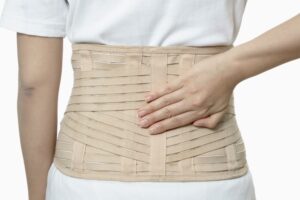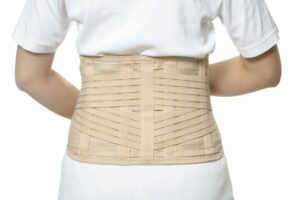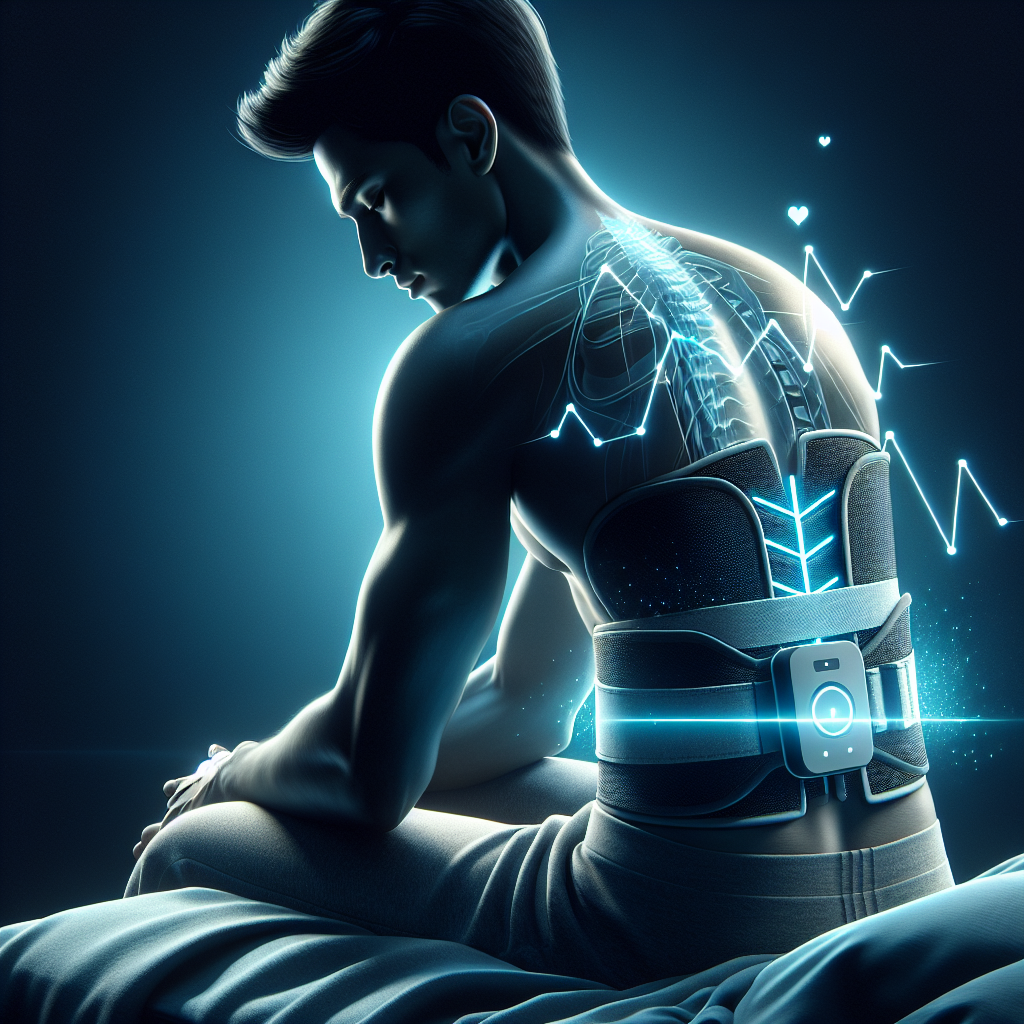
Can Technology Like Wearable Posture Correctors Aid In Lower Back Pain Relief?
Imagine finally finding a solution to your constant lower back pain without having to undergo invasive treatments or rely on medication. With the advancement of technology, wearable posture correctors have emerged as a potential game-changer in the field of pain relief. Designed to gently remind you to maintain a posture that aligns with the natural curvature of your spine, these devices not only offer instant relief but also work towards correcting the root cause of your discomfort. Can this innovative technology bring an end to your lower back pain struggles? Let’s explore the potential benefits of wearable posture correctors in aiding lower back pain relief.
Overview of Lower Back Pain
Lower back pain refers to discomfort or pain that is experienced in the area between the ribcage and the buttocks, known as the lumbar region. It is a widespread condition that affects a significant percentage of the population, causing varying degrees of discomfort and limitations in daily activities. While lower back pain can have numerous causes, it is essential to understand its prevalence and the impact it can have on individuals’ lives.
Definition of lower back pain
Lower back pain is a condition characterized by discomfort or pain in the lumbar region of the spine. It can range from mild to severe and may be experienced as a dull ache, sharp pain, or even a persistent throbbing sensation. The severity and duration of the pain can vary from person to person, and it can be acute or chronic in nature. Acute lower back pain typically lasts for a few days to a few weeks, while chronic lower back pain persists for longer durations, often exceeding three months.
Causes of lower back pain
Lower back pain can be caused by various factors, including muscle strains, spinal disc injuries, herniated discs, spinal stenosis, poor posture, and degenerative conditions like arthritis. Muscle strains can occur due to sudden movements, lifting heavy objects, or improper lifting techniques. Spinal disc injuries can be the result of trauma or wear and tear over time, leading to bulging or herniated discs. Spinal stenosis refers to the narrowing of the spinal canal, which can put pressure on the nerves in the lumbar region.
Prevalence of lower back pain
Lower back pain is a highly prevalent condition that affects individuals across different age groups and demographics. According to research, it is estimated that approximately 80% of adults will experience lower back pain at some point in their lives. It is one of the leading causes of disability worldwide, often leading to missed days at work, reduced productivity, and a significant economic burden on individuals and healthcare systems.

This image is property of images.unsplash.com.
Impact of lower back pain on daily life
Lower back pain can have a significant impact on a person’s daily life, affecting their ability to perform simple tasks, engage in physical activities, and enjoy their usual hobbies. The pain can limit mobility, making it challenging to stand, sit, or walk for extended periods. It can also disrupt sleep patterns, leading to fatigue and decreased overall well-being. The chronic nature of lower back pain can contribute to emotional distress, anxiety, and depression, further diminishing the quality of life.
Wearable Posture Correctors
With the advancement of technology, wearable posture correctors have emerged as a potential solution for addressing lower back pain and improving posture. These devices are designed to be worn on the body, providing support and guidance to the spine, muscles, and joints, ultimately helping to maintain proper posture and alleviate the discomfort associated with lower back pain.
Introduction to wearable posture correctors
Wearable posture correctors are innovative devices that utilize technology to promote better posture and provide support to the musculoskeletal system. These devices come in various forms, including braces, belts, shirts, and even smart garments equipped with sensors and actuators. By gently reminding the wearer to maintain correct alignment, wearable posture correctors aim to train the body to adopt healthier postural habits, reducing the strain on the lower back.
Types of wearable posture correctors
There are several types of wearable posture correctors available on the market, each designed to cater to different individuals and their unique needs. Some posture correctors are specifically focused on supporting the lower back, while others provide more comprehensive upper body support. Additionally, some devices are discreet and adjustable, allowing for personalized comfort and convenience, while others incorporate technology like sensors and mobile applications to provide real-time feedback and progress tracking.

How wearable posture correctors work
Wearable posture correctors function by providing external support to the spine and surrounding muscles, encouraging proper alignment and reducing stress on the lower back. These devices are typically designed to restrict certain movements that contribute to poor posture, such as slouching or hunching forward. They gently pull the shoulders back, lift the chest, and align the spine to promote a more upright and natural posture. Some wearable posture correctors use sensors to detect changes in posture and provide feedback to the wearer, reinforcing the desired alignment.
Benefits of using wearable posture correctors
Wearable posture correctors offer several benefits for individuals struggling with lower back pain. Firstly, they provide immediate support and relief by reducing the strain on the muscles and joints of the lower back. This support can aid in pain reduction and help individuals regain mobility and function. Secondly, wearable posture correctors help in training the body to adopt healthier postural habits, gradually reducing the need for external support. Thirdly, these devices can serve as a gentle reminder to maintain correct alignment throughout the day, promoting better posture and preventing future episodes of lower back pain.
Emergence of technology in healthcare
The healthcare industry has witnessed a significant influx of technology, revolutionizing the way diseases and conditions are diagnosed, treated, and managed. Technological advancements have not only enhanced the accuracy and efficiency of medical procedures but have also opened up new possibilities for pain management and rehabilitation. Wearable posture correctors are just one example of how technology can aid in improving the quality of life for individuals suffering from lower back pain.
Advancements in technology for lower back pain relief
In recent years, technology has played a vital role in developing innovative solutions for lower back pain relief. Wearable posture correctors equipped with sensors and actuators can detect changes in body alignment and provide real-time feedback to the wearer. This feedback allows individuals to make immediate adjustments to their posture, actively engaging in the correction process. Additionally, technology has facilitated the development of wearable devices that can be seamlessly integrated into everyday life, ensuring continuous support and pain relief.

Effectiveness of technology-based solutions for pain management
Numerous studies have explored the effectiveness of technology-based solutions, such as wearable posture correctors, in managing lower back pain. Research has shown that these devices can significantly improve posture, reduce muscle tension, and alleviate pain. A study published in the Journal of Physical Therapy Science found that the use of wearable posture correctors resulted in improved spinal alignment, decreased muscle activity, and enhanced overall posture. These findings suggest that technology-based solutions can be a valuable tool in the management of lower back pain.
Traditional methods of lower back pain relief
Traditional methods of lower back pain relief typically include approaches such as physical therapy, chiropractic care, medication, and lifestyle modifications. Physical therapy aims to strengthen the muscles supporting the spine, improve flexibility, and correct postural imbalances. Chiropractic care involves manual adjustments to the spine, aiming to restore proper alignment and alleviate pain. Medications, such as nonsteroidal anti-inflammatory drugs (NSAIDs), may be prescribed to manage pain and reduce inflammation. Lifestyle modifications often include adopting a regular exercise routine, maintaining a healthy weight, and practicing proper body mechanics.
Limitations of traditional methods
While traditional methods of lower back pain relief can be effective, they may have limitations in providing long-term and sustainable relief. Physical therapy and chiropractic care require frequent sessions, which may not be convenient or accessible for everyone. Medications can have side effects and may only offer temporary relief. Lifestyle modifications can be challenging to implement consistently, especially for individuals with busy schedules or physical limitations. Therefore, there is a need for alternative approaches that can supplement or enhance traditional methods of pain management.
Exploring alternative approaches to pain management
Considering the limitations of traditional methods, alternative approaches to pain management have gained prominence, focusing on holistic and multidisciplinary approaches. These approaches incorporate a combination of techniques like exercise therapy, mindfulness practices, acupuncture, and now wearable posture correctors. By combining various modalities, individuals can benefit from a personalized and comprehensive approach to managing their lower back pain. These alternatives often prioritize self-care, empowering individuals to take an active role in their pain management journey.

Biomechanics of posture correction
The biomechanics of posture correction involves understanding how the musculoskeletal system functions and the impact of external factors on its alignment. Proper posture relies on the coordination of various muscles, ligaments, and joints, working together to maintain balance and support the spine. When these structures are misaligned or put under excessive stress, it can result in lower back pain and postural abnormalities. Wearable posture correctors aim to correct these imbalances by providing external support and guiding the body into a more aligned position.
How wearable devices monitor posture
Wearable devices designed to monitor posture typically utilize sensors and accelerometers to detect changes in body position and alignment. These sensors can detect slouching, hunching, or other postural deviations, and provide real-time feedback to the wearer. The feedback can be delivered through various means, including vibrations, audio cues, or visual indicators. By accurately tracking posture, these devices help individuals become aware of their postural habits, encouraging them to make conscious adjustments throughout the day.
Potential impact on lower back pain
Correcting posture can have a significant impact on reducing lower back pain. Proper alignment ensures that the weight of the body is evenly distributed, minimizing stress on the lumbar region. By providing external support and promoting correct posture, wearable devices can reduce muscle tension, relieve pressure on the intervertebral discs, and prevent excessive wear and tear on the spinal structures. Over time, this can lead to a reduction in lower back pain and an improvement in overall spinal health.
Overview of relevant research studies
Several research studies have explored the effectiveness of wearable posture correctors in managing lower back pain and improving posture. One study published in the Journal of Back and Musculoskeletal Rehabilitation investigated the effects of wearing a posture corrective brace on muscle activity and posture in individuals with chronic lower back pain. The results demonstrated a significant reduction in muscle activity and an improvement in spinal alignment, indicating that wearable posture correctors can be an effective adjunctive treatment for lower back pain.

Findings on the effectiveness of wearable posture correctors
The findings from various studies on wearable posture correctors consistently indicate their effectiveness in improving posture and reducing lower back pain. Researchers have observed improvements in spinal alignment, decreased muscle activity, and pain reduction among individuals using these devices. Additionally, a study published in Applied Ergonomics found that wearing a wearable posture corrector led to increased awareness of posture and a reduction in reported discomfort during prolonged sitting. These findings highlight the potential of wearable posture correctors in addressing the challenges of sedentary lifestyles and promoting spinal health.
Addressing concerns and limitations
While research supports the effectiveness of wearable posture correctors, it is essential to address concerns and limitations associated with their use. Some individuals may find these devices uncomfortable or restrictive, especially if they are not properly fitted or do not allow for a full range of motion. Additionally, wearable posture correctors should not be relied upon as the sole solution for lower back pain relief. They work best when combined with other strategies, such as exercise, physical therapy, and ergonomic adjustments. It is crucial for individuals to consult healthcare professionals and specialists to determine the most suitable approach for their specific condition and needs.
Factors to consider when selecting a posture corrector
When choosing a wearable posture corrector, several factors should be taken into consideration. Firstly, the level of support required should be assessed to determine whether a device focused on the lower back or a more comprehensive upper body support is necessary. Secondly, the comfort and adjustability of the device should be considered, as it should be comfortable enough to wear for extended periods without causing discomfort or skin irritation. The durability and quality of the materials used are also important, as it should withstand regular use without losing its effectiveness. Lastly, individuals should consider their lifestyle and daily activities to ensure compatibility with their needs.
Different features and functionalities available
Wearable posture correctors come with a variety of features and functionalities to cater to the diverse needs of users. Some devices incorporate sensors or accelerometers to monitor posture and provide real-time feedback. Others may have adjustable straps or fastenings to ensure optimal comfort and fit. Certain devices are designed to be discreet, allowing individuals to wear them under clothing without drawing attention. Additionally, some posture correctors offer mobile applications or connected platforms that enable individuals to track their progress, set reminders, and access additional resources for proper posture maintenance.
Compatibility with personal lifestyle and needs
Choosing the right wearable posture corrector depends on how well it fits into an individual’s personal lifestyle and needs. For those with an active lifestyle, it may be beneficial to select a device that offers flexibility and ease of movement. On the other hand, individuals with sedentary jobs may prefer a device that provides ongoing support and reminders for maintaining correct posture during prolonged sitting. Understanding personal preferences, activity levels, and overall goals can help in selecting a wearable posture corrector that seamlessly integrates into daily life and effectively addresses lower back pain.
Real-life stories of individuals using posture correctors
Numerous individuals have reported positive experiences and outcomes after using wearable posture correctors. Sarah, a 35-year-old office worker, shares how wearing a posture corrector has made a significant difference in her daily life. She mentions that her lower back pain has reduced, and she feels more energized and focused throughout the day. Mark, a 42-year-old fitness enthusiast, highlights how using a posture corrector during workouts has improved his form and prevented strain on his lower back. These real-life stories demonstrate the impact that wearable posture correctors can have on pain management and overall well-being.
Positive impact on pain management
Users of wearable posture correctors commonly report a positive impact on their pain management journey. The external support provided by these devices helps to alleviate discomfort and reduce the strain on the lower back. Individuals often notice a decrease in muscle tension and a reduction in pain intensity with regular use. The ability to maintain proper alignment and posture throughout the day contributes to improved spinal health and a more comfortable daily experience. By actively engaging in postural correction, users can take control of their pain and actively contribute to their overall well-being.
Challenges and drawbacks reported by users
While wearable posture correctors offer significant benefits, some users may face challenges or drawbacks when using these devices. One common concern is discomfort or skin irritation resulting from prolonged use or improper fit. It is essential to ensure that the device is properly adjusted and fits comfortably to avoid discomfort. Additionally, some individuals may rely too heavily on the external support, neglecting other aspects of pain management, such as exercise or physical therapy. It is crucial to strike a balance between the use of wearable posture correctors and other strategies to achieve optimal results.
Insights from healthcare professionals and specialists
Healthcare professionals and specialists play a crucial role in evaluating and recommending the use of wearable posture correctors. Their expertise and knowledge can help individuals make informed decisions based on their specific condition and needs. Dr. Emily Stevens, a chiropractor, explains that wearable posture correctors can provide valuable support while individuals work on improving their posture and overall spinal health. She emphasizes the importance of combining the use of these devices with other modalities, such as exercise and lifestyle modifications, to achieve long-lasting results.
Benefits and potential drawbacks according to experts
Experts acknowledge the potential benefits of wearable posture correctors for managing lower back pain and improving posture. Dr. James Johnson, a physical therapist, highlights the immediate relief and support these devices can provide. He also emphasizes the importance of understanding that wearable posture correctors should not be relied upon as the sole solution. According to Dr. Johnson, individuals should view these devices as tools that complement and enhance the effectiveness of other pain management strategies.
Professional recommendations and guidelines
Healthcare professionals and specialists generally recommend the use of wearable posture correctors as part of a comprehensive approach to lower back pain relief. They emphasize the importance of consulting with a healthcare professional to determine the most suitable device based on individual needs and preferences. Additionally, professionals encourage individuals to incorporate other strategies, such as exercise, stretching, and ergonomic adjustments, to address the underlying causes of lower back pain. Regular check-ins with healthcare professionals can provide guidance and monitor progress, ensuring the best outcomes for individuals using wearable posture correctors.
Summary of the benefits and limitations of wearable posture correctors
In summary, wearable posture correctors offer several benefits for individuals struggling with lower back pain. They provide immediate support, promote better posture, and contribute to reduced muscle tension and pain. However, it is essential to consider their limitations, such as discomfort or skin irritation in some cases. It is crucial to use these devices as part of a comprehensive approach to pain management, incorporating other strategies like exercise, physical therapy, and lifestyle modifications.
Future potentials and developments in the field
The field of wearable posture correctors is continually evolving, with ongoing research and development aimed at improving their effectiveness and user experience. Future developments may include advancements in sensor technology to provide even more accurate and insightful feedback. The integration of artificial intelligence and machine learning algorithms could enable personalized recommendations and adaptive adjustments based on individual progress. Additionally, more comfortable and discreet designs may become available, further enhancing the usability and acceptance of wearable posture correctors.
Importance of consulting healthcare professionals for personalized advice
It is crucial for individuals experiencing lower back pain to seek personalized advice from healthcare professionals before using wearable posture correctors or implementing any pain management strategies. Healthcare professionals can assess the specific condition, identify underlying causes, and recommend the most appropriate treatment approach. They can also provide guidance on using wearable posture correctors safely and effectively, ensuring optimal outcomes and a healthier, pain-free lifestyle.









